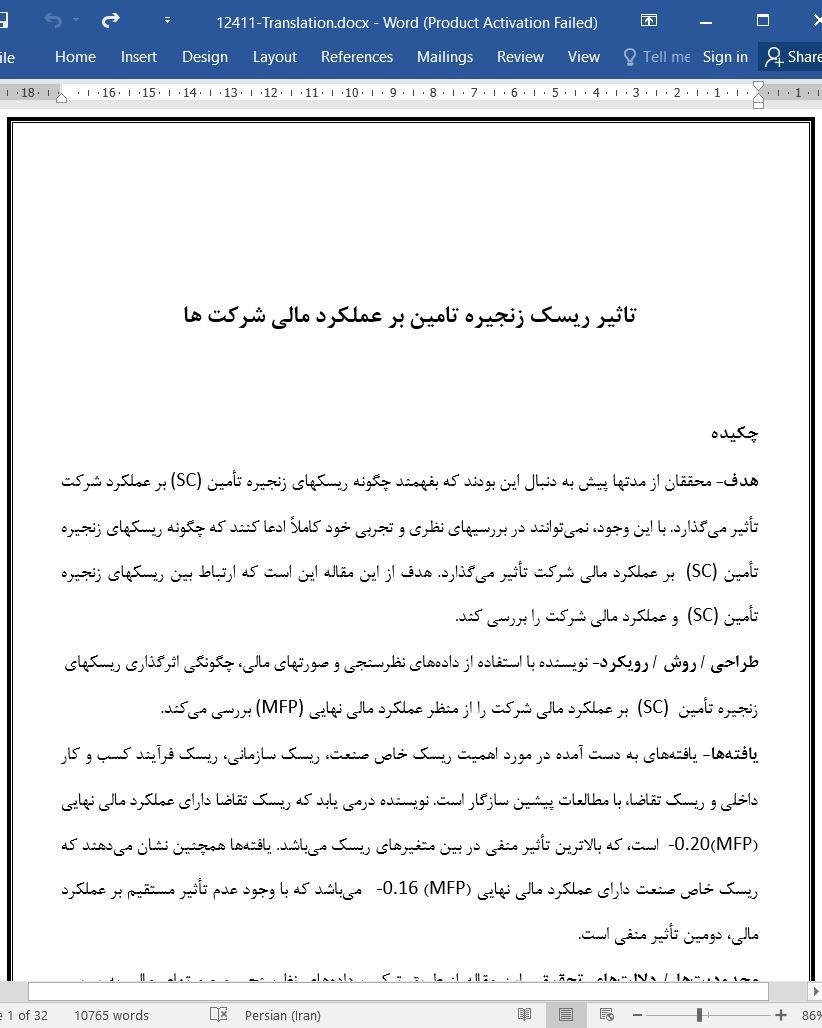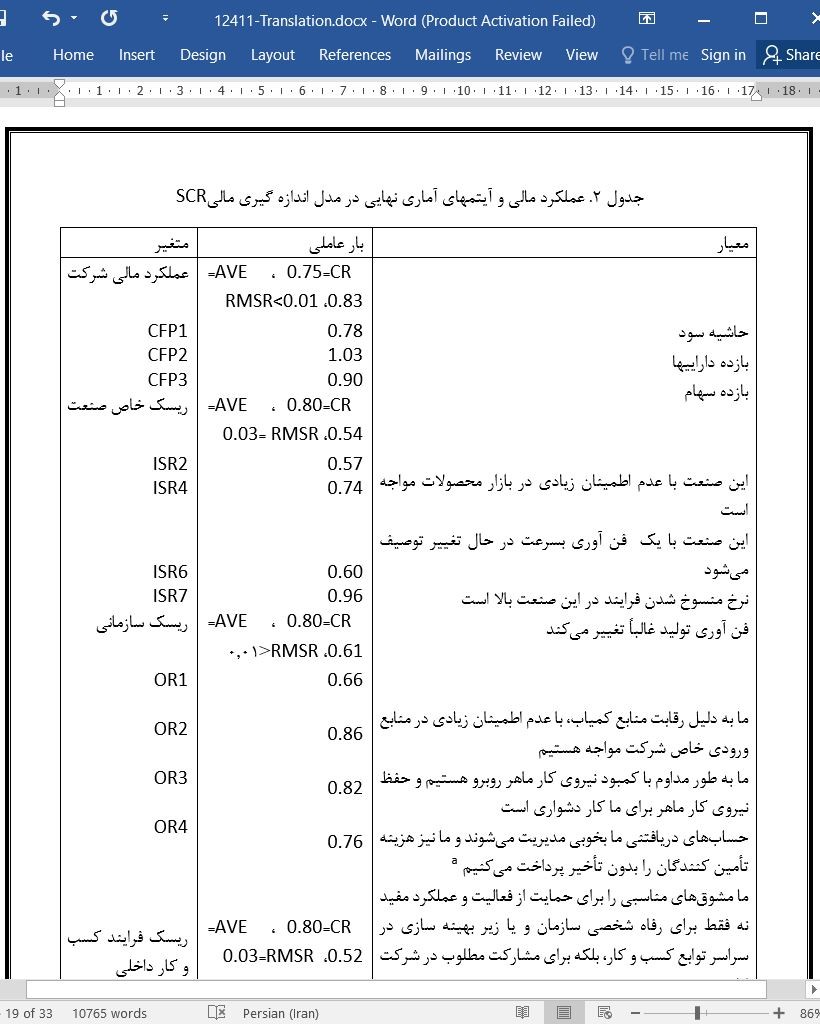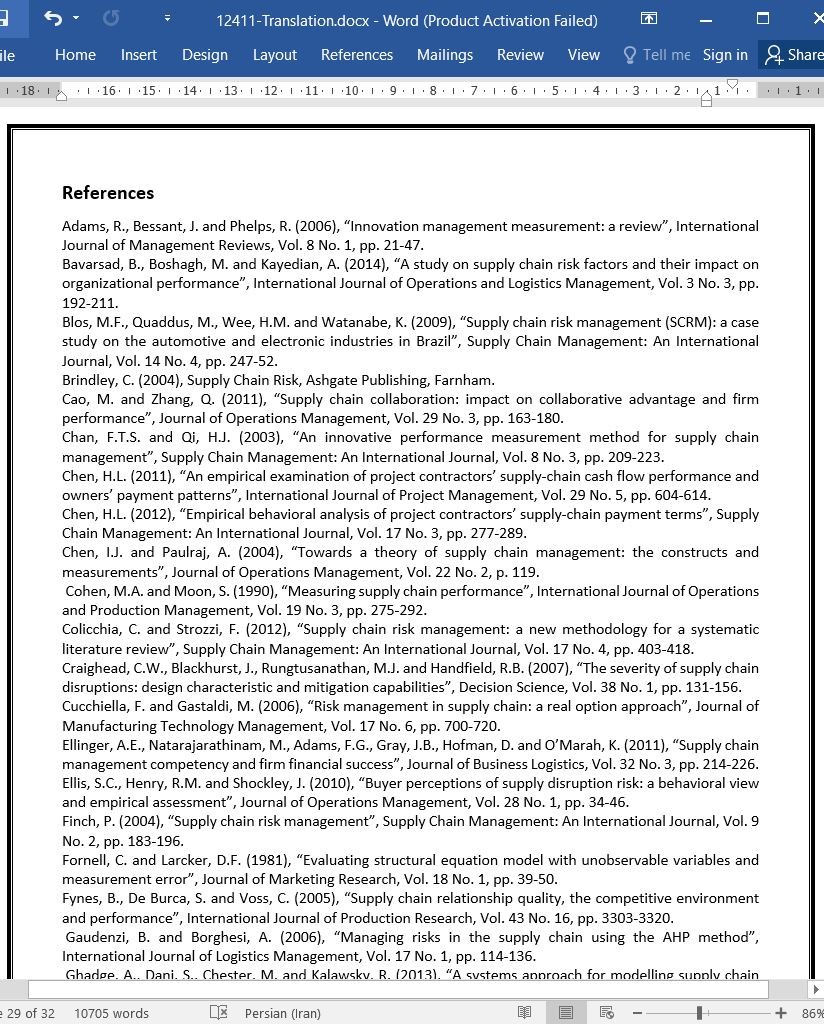
دانلود مقاله تاثیر ریسک زنجیره تامین بر عملکرد مالی شرکت ها
چکیده
هدف- محققان از مدتها پیش به دنبال این بودند که بفهمند چگونه ریسکهای زنجیره تأمین (SC) بر عملکرد شرکت تأثیر میگذارد. با این وجود، نمیتوانند در بررسیهای نظری و تجربی خود کاملاً ادعا کنند که چگونه ریسکهای زنجیره تأمین (SC) بر عملکرد مالی شرکت تأثیر میگذارد. هدف از این مقاله این است که ارتباط بین ریسکهای زنجیره تأمین (SC) و عملکرد مالی شرکت را بررسی کند.
طراحی / روش / رویکرد- نویسنده با استفاده از دادههای نظرسنجی و صورتهای مالی، چگونگی اثرگذاری ریسکهای زنجیره تأمین (SC) بر عملکرد مالی شرکت را از منظر عملکرد مالی نهایی (MFP) بررسی میکند.
یافتهها- یافتههای به دست آمده در مورد اهمیت ریسک خاص صنعت، ریسک سازمانی، ریسک فرآیند کسب و کار داخلی و ریسک تقاضا، با مطالعات پیشین سازگار است. نویسنده درمی یابد که ریسک تقاضا دارای عملکرد مالی نهایی (MFP) -0.20 است، که بالاترین تأثیر منفی در بین متغیرهای ریسک میباشد. یافتهها همچنین نشان میدهند که ریسک خاص صنعت دارای عملکرد مالی نهایی (MFP) -0.16 میباشد که با وجود عدم تأثیر مستقیم بر عملکرد مالی، دومین تأثیر منفی است.
محدودیتها / دلالتهای تحقیق- این مقاله از طریق ترکیب دادههای نظرسنجی و صورتهای مالی به بررسی چگونگی تأثیر ریسکهای زنجیره تأمین (SC) بر عملکرد مالی نهایی (MFP) میپردازد. و فرض نمیکند که برآوردهای گزارش شده در مورد عملکرد مالی نهایی (MFP) برای همه کسب و کارها در کشورهای دیگر اعمال شود. با این حال، تحقیقات آینده میتواند یافتههای ما را بصورت مثلث در بیاورد.
اصالت/ارزش- این مطالعه نظرسنجی و دادههای مالی را با هم ترکیب میکند تا چگونگی اثرگذاری ریسکهای زنجیره تأمین (SC) بر عملکرد مالی شرکت را تحلیل کند. بخصوص، روشی را برای برآورد روابط علت و معلولی کمّی بین ریسک زنجیره تأمین (SC) و عملکرد مالی شرکت فراهم میکند، که به این عنوان مهم در تحقیقات در زمینه مدیریت زنجیره تأمین توجه کمتری شده است.
1. مقدمه
در محیطهای تجاری مدرن که با رقابت فزاینده و جهانی سازی توصیف میشوند، مدیران برای دستیابی به مزیت رقابتی و حفظ آن از فن آوریها و استراتژیهای نوآورانهای استفاده میکنند (Chan و Qi، 2003). از آنجاییکه زنجیرههای تأمین (SC) شامل همه فعالیتهای مرتبط با جریان و تبدیل کالاها از مرحله ماده اولیه تا کاربر نهایی است (Handfield و Nichols، 1999)، مدیریت مؤثر ریسک زنجیره تأمین (SCRM) از طریق هماهنگی و همکاری بین شرکای زنجیره تأمین (SC) برای تضمین سودآوری و تداوم یک امر کلیدی است (Brindley، 2004؛ Tang، 2006). جای تعجب نیست که تعداد مقالات قابل توجهی در مورد این موضوع ارائه شدهاند (برای مثال، Kleindorfer و Saad، 2005؛ Ritchie و Brindley، 2007؛ Rotaru و همکاران، 2014؛ Zsidisin 2003؛ Zsidisin و Ellram، 2003).
به عنوان مثال، یکی از یافتههای اخیر این است که دو عامل در سطح سازمان یعنی شباهت عملیاتی ادراک شده و رهبری بازار، بر احتمال یادگیری مدیر ریسک در مورد آنچه میتواند موجب زیانهای عملیاتی سایر شرکتها شود تأثیر قابل توجهی دارند (Hora و Klassen، 2013). یافته دیگر این است که بهبود ادغام داخلی فرآیندهای اصلی کسب و کار در یک شرکت، دید تقاضا را افزایش میدهد و در نتیجه ریسک تقاضا را کاهش میدهد (Kache و Seuring، 2014).
7. نتیجه گیری
مطالعات گسترده در زمینه مدیریت زنجیره تأمین (SCM) ، مدلهای مدیریت ریسک زنجیره تأمین (SCRM) را از طریق بررسی و شناسایی عوامل تعیین کننده عملکرد ریسک در زنجیرههای تأمین توسعه میدهند. با این حال، تعداد کمی از مطالعات نحوه تاثیرگذاری تغییر در ریسکهای زنجیره تأمین را بر عملکرد مالی شرکت مورد بررسی قرار میدهند. بنابراین، این مطالعه یک مدل مالی SCR شرکتی را با استفاده از یک روش ترکیبی نظرسنجی و گزارشات مالی، بر اساس دیدگاه عملکرد مالی نهایی (MFP) مطرح میکند. تجزیه و تحلیل مدل مالی SCR این مسئله را آشکار میسازد که ریسک تقاضا بیشترین تأثیر منفی (MFP=-0.20) را بر عملکرد مالی شرکت ایجاد میکند و ریسک خاص صنعت دومین تأثیر بزرگ منفی (MFP=-0.16) را بر عملکرد مالی شرکت دارد، هر چند که خود آن تأثیر مستقیمی ندارد.
این مطالعه با افزودن به مزایای مدلهای موجود SCRM (برای مثال، Bavarsad و همکاران، 2014؛ Cao و Zhang، 2011؛ Ghadge و همکاران، 2013؛ Ritchie و Brindley، 2007؛ Tracey و همکاران، 2005؛ Zhaoو همکاران، 2013)، روشی را برای ارزیابی تأثیر SCR بر عملکرد مالی ارائه میدهد. بنابراین، این مطالعه بخشی از پیشرفتهای اساسی در مدلهای عملکرد مدیریت ریسک زنجیره تأمین (SCRM) را مورد توجه قرار میدهد. با این وجود، لازم است که تحقیقات بیشتری برای روشن شدن بیشتر تأثیرات ناچیز ریسک سازمانی و ریسک عرضه بر ریسک تقاضا و عملکرد مالی شرکت انجام شود، هرچند که توضیحات احتمالی متعددی برای آن ارائه شدهاند.
Abstract
Purpose – Researchers have long sought to understand how risks in supply chains (SCs) affect firm performance. Yet, they have not fully subjected claims of how SC risks affect firm financial performance to theoretical and empirical scrutiny. The purpose of this paper is to investigate the links between SC risks and firm financial performance.
Design/methodology/approach – The author analyzes how SC risks affect firm financial performance from the perspective of marginal financial performance (MFP) using survey and financial statement data. The author employs structural equation modeling to examine the hypotheses using 106 Taiwanese listed companies across 20 industries.
Findings – The findings regarding the importance of industry-specific risk, organizational risk, internal business process risk, and demand risk are consistent with prior studies. The author finds that demand risk has an MFP of −0.20, the highest negative effect among the risk variables. The findings also show that industry-specific risk possesses an MFP of −0.16, the second-highest negative effect, despite having no direct effect on financial performance.
Research limitations/implications – This paper examines how SC risks affect MFP via combining survey and financial statement data. It does not assume the reported MFP estimates apply to all businesses in other countries. However, future research could triangulate our findings.
Originality/value – This study combines survey and financial data to analyze how SC risks affect firm financial performance. Specifically, it provides a methodology for estimating quantitative cause-effect relationships between SC risk and firm financial performance, an important topic that receives less research interest in the field of supply chain management.
1. Introduction
In modern business environments characterized by ever-increasing competition and globalization, managers use innovative technologies and strategies to achieve and sustain competitive advantages (Chan and Qi, 2003). Because supply chains (SCs) consist of all activities associated with the flow and transformation of goods from the raw material stage to the end user (Handfield and Nichols, 1999), effective supply chain risk management (SCRM) via coordination and collaboration among SC partners is key to ensuring profitability and continuity (Brindley, 2004; Tang, 2006). Not surprisingly, a considerable amount of literature has accumulated on the subject (e.g. Kleindorfer and Saad, 2005; Ritchie and Brindley, 2007; Rotaru et al., 2014; Zsidisin, 2003; Zsidisin and Ellram, 2003).
One recent finding, for example, is that two organization-level factors, perceived operational similarity and market leadership, significantly influence the risk manager’s likelihood of learning what might trigger other firms’ operational losses (Hora and Klassen, 2013). Another finding is that improved internal integration of core business processes within a company enhances demand visibility and thus decreases demand risk (Kache and Seuring, 2014).
7. Conclusions
Extensive studies in the SCM field develop SCRM models through examining and identifying the determinants of risk performance in SCs. However, few studies investigate how changes in SC risks affect firm financial performance. This study therefore develops a corporate SCR financial model based on the MFP perspective using the combined method of a survey and financial reports. Analysis of the SCR financial model reveals that demand risk produces the largest negative impact (MFP ¼ −0.20) on corporate financial performance, and industry-specific risk generates the second largest negative impact (MFP ¼ −0.16) on corporate financial performance, although itself without direct effect.
By adding to the benefits of existing SCRM models (e.g. Bavarsad et al., 2014; Cao and Zhang, 2011; Ghadge et al., 2013; Ritchie and Brindley, 2007; Tracey et al., 2005; Zhao et al., 2013), this study contributes a methodology for estimating the effects of SCRs on financial performance. Thus, this study addresses part of the fundamental improvement of SCRM performance models. Nonetheless, more research is needed to further clarify the nonsignificant impacts of organizational risk and supply risk on demand risk and corporate financial performance, respectively, although several possible explanations are provided.
H1a. Supply risk is positively related to industry-specific uncertainties.
H1b. Demand risk is positively related to industry-specific uncertainties.
H2a. Supply risk is positively related to organizational risk.
H2b. Demand risk is positively related to organizational risk.
H3a. Supply risk is positively related to internal business process risk.
H3b. Demand risk is positively related to internal business process risk.
H4. Supply risk has a significant negative effect on firm financial performance.
H5. Demand risk has a significant negative effect on firm financial performance.
H1a. ریسک عرضه رابطه مثبتی با عدم قطعیتهای خاص صنعت دارد.
H1b. ریسک تقاضا رابطه مثبتی با عدم قطعیتهای خاص صنعت دارد.
H2a. ریسک عرضه رابطه مثبتی با ریسک سازمانی دارد.
H2b. ریسک تقاضا رابطه مثبتی با ریسک سازمانی دارد.
H3a. ریسک عرضه رابطه مثبتی با ریسک فرایند کسب و کار داخلی دارد.
H3b. ریسک تقاضا رابطه مثبتی با ریسک فرایند کسب و کار داخلی دارد.
H4. ریسک عرضه تأثیر منفی قابل توجهی بر عملکرد مالی شرکت دارد.
H5. ریسک تقاضا تأثیر منفی قابل توجهی بر عملکرد مالی شرکت دارد.
چکیده
1. مقدمه
2. پیشینه تحقیق
3. فرضیات تحقیق
4. روش تحقیق
4.1. شرکت کنندگان و روندها
4.2. معیارها و تجزیه و تحلیل
5. نتایج تحقیق
5.1. تحلیل مدلهای جداگانه
5.2. تحلیل مدل اندازه گیری کلی
5.3. بررسی مدل مالی SCR شرکت
6. بحث
7. نتیجه گیری
منابع
Abstract
1. Introduction
2. Research background
3. Research hypotheses
4. Research methodology
4.1 Participants and procedures
4.2 Measures and analysis
5. Research results
5.1 Analysis of isolated models
5.2 Analysis of overall measurement model
5.3 Testing the corporate SCR financial model
6. Discussion
7. Conclusions
References
- اصل مقاله انگلیسی با فرمت ورد (word) با قابلیت ویرایش
- ترجمه فارسی مقاله با فرمت ورد (word) با قابلیت ویرایش، بدون آرم سایت ای ترجمه
- ترجمه فارسی مقاله با فرمت pdf، بدون آرم سایت ای ترجمه



